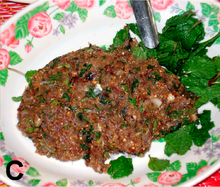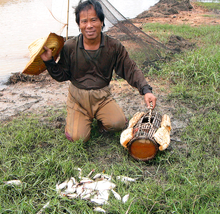- Opisthorchis viverrini
-
Opisthorchis viverrini 
An adult Opisthorchis viverrini prepared on a microscope slide Scientific classification 
Kingdom: Animalia Phylum: Platyhelminthes Class: Trematoda Order: Opisthorchiida Family: Opisthorchiidae Genus: Opisthorchis Species: O. viverrini Binomial name Opisthorchis viverrini
(Poirier, 1886) Stiles & Hassal, 1896Synonyms[1] Distoma viverrini Poirier, 1886
Opisthorchis viverrini, common name Southeast Asian liver fluke, is a trematode parasite from the family Opisthorchiidae that attacks the area of the bile duct. Infection is acquired when people ingest raw or undercooked fish.[2] It causes the disease opisthorchiasis (also called clonorchiasis).[3] Opisthorchis viverrini infection also predisposes the infected for cholangiocarcinoma, a cancer of the gall bladder and/or its ducts.
Opisthorchis viverrini (together with Clonorchis sinensis and Opisthorchis felineus) is one of the three most medically important species in the family Opisthorchiidae.[3]
Opisthorchis viverrini is endemic throughout Thailand, the Lao People's Democratic Republic, Vietnam and Cambodia.[4] In Northern Thailand, it is widely distributed, with high prevalence in humans, while in Central Thailand there is low rate of prevalence.[5] The disease opisthorchiasis (caused by Opisthorchis viverrini) does not occur in southern Thailand.[5]
 An adult Opisthorchis viverrini has these main body parts: oral sucker, pharynx, caecum, ventral sucker, vitellaria, uterus, ovary, Mehlis' gland, testes, exretory bladder. (See notes on the image.)
An adult Opisthorchis viverrini has these main body parts: oral sucker, pharynx, caecum, ventral sucker, vitellaria, uterus, ovary, Mehlis' gland, testes, exretory bladder. (See notes on the image.)
Contents
Description
 An egg of Opisthorchis viverrini. 400× magnification.
An egg of Opisthorchis viverrini. 400× magnification.
The testes of an adult Opisthorchis viverrini are lobed[1] in comparison of dendritic testes of Clonorchis sinensis.[1]
The eggs of Opisthorchis viverrini are 30 × 12 μm in size[1] and they are slightly narrower and more regularly ovoid than in Clonorchis sinensis.[1] But eggs of Opisthorchis viverrini are visually indisgushiable in Kato technique smears from other eggs of flukes from other fluke family Heterophyidae.[6]
The metacercariae of Opisthorchis viverrini are brownish, eliptical with two nearly equal-sized suckers: the oral sucker and the ventral sucker.[6] They are 0.19-0.25 × 0.15-0.22 mm in size.[6]
Life cycle
Opisthorchis viverrini is a hermaphroditic liver fluke.[4] Its life cycle is similar to the life cycle of Clonorchis sinensis.[4] It involves a freshwater snail, in which asexual reproduction takes place, and freshwater cyprinid fishes (family Cyprinidae) as intermediate hosts. Fish–eating (= piscivorous) mammals, including humans, dogs and cats, act as definitive hosts, in which sexual reproduction occurs.[4] As a result of poor sanitation practices and inadequate sewerage infrastructure, Opisthorchis viverrini-infected people pass the trematode's eggs in their feces into bodies of fresh water.[2]
First intermediate host
The first intermediate hosts include freshwater snails of the genus Bithynia.[7] The only known host is Bithynia siamensis (that include all its three subspecies).[1][8] Aquatic snails, which represent the first intermediate hosts of Opisthorchis viverrini, ingest the eggs from which the miracidia undergo asexual reproduction before a population of the free swimming larval stage, called a cercaria, is shed from the infected snails.[2]
Second intermediate host
The cercaria then locates a cyprinoid fish, encysts in the fins, skin and musculature of the fish, and becomes a metacercaria.[2] Habitats of second intermediate hosts of Opisthorchis viverrini include freshwater habitats with stagnant or slow-moving waters (ponds, river, aquaculture, swamps, rice fields).[9]
In 1965 there were known 9 fish hosts of Opisthorchis viverrini.[10] Up to 2002 there were known 15 species of fishes from 7 genera of the family Cyprinidae, that serves as second intermediate host.[1] Further research by Rim et al. (2008)[6] showed additional five more host species:
- Puntius brevis[6]
- Puntius gonionotus - synonym: Barbonymus gonionotus, Java Barb[6]
- Puntius orphoides[1][6]
- Puntius proctozysron - synonym: Puntioplites proctozystron[6]
- Puntius viehoeveri - synonym: Barbonymus gonionotus[6]
- Hampala dispar[1][6]
- Hampala macrolepidota[6]
- Cyclocheilichthys armatus[6] - synonym: Cyclocheilichthys siaja[11]
- Cyclocheilichthys repasson[6]
- Labiobarbus lineatus[6]
- Esomus metallicus[6]
- Mystacoleucus marginatus[6]
- Puntioplites falcifer[6]
- Onychostoma elongatum[6]
- Osteochilus hasseltii[6]
- Hypsibarbus lagleri[6]
- Barbodes gonionotus - synonym: Barbonymus gonionotus[6]
Definitive host
 The finished dish of Koi pla made of raw fish accompanied by rice and vegetables. This dish is a dietary staple of many northeastern Thai villagers and is a common source of infection with Opisthorchis viverrini.[12]
The finished dish of Koi pla made of raw fish accompanied by rice and vegetables. This dish is a dietary staple of many northeastern Thai villagers and is a common source of infection with Opisthorchis viverrini.[12]
The metacercarial stage is infective to humans and other fish-eating mammals[2] including dogs and cats.[4] The natural definitive host is the Leopard Cat (Prionailurus bengalensis).[1] The young adult worm escapes from the metacercarial cyst in the upper small intestine and then migrates through the ampulla of Vater into the biliary tree, where it develops to sexual maturity over four to six weeks, thus completing the life cycle.[2]
Fish contain more metacercaria from September to February, before the dry season[1][10] and this is the period, when humans are usually infected.[1] Infection is acquired when people ingest raw or undercooked fish.[2] Dishes of raw fish are common in the cuisine of Laos and the cuisine of Thailand: koi-pla, raw fish in spicy salad lab-pla,[8] salted semi-fermented fish dishes called pla-ra (pla ra),[1] pla som[8] and Som fak.[6]
The adult worms, which are hermaphrodites, can live for many years in the liver, even decades, shedding as many as 200 eggs per day which pass out via bile into the chyme and feces.[2] The lifespan of Opisthorchis viverrini is over 10 years.[11]
Opisthorchis viverrini secretes a granulin-like growth protein especially in its gut and integument.[13]
Effect on human health
Main article: OpisthorchiasisMedical care and loss of wages caused by Opisthorchis viverrini in Laos and in Thailand costs about $120 million annually[1] or $120 million per year can cost Northeast Thailand only.[3]
Infection of Opisthorchis viverrini and of other liver flukes in Asia affect the poor and poorest people.[14] Opisthorchiasis have received less attention in comparison of other diseases and it is a neglected disease in Asia.[14]
Genetics
Currently, a total of only ~5,000[2] expressed sequence tags (ESTs) are publicly available for Opisthorchis viverrini, a dataset far too small to give sufficient insights into transcriptomes for the purpose of supporting genomic and other fundamental molecular research.[4]
Although the genome size of Opisthorchis viverrini has not yet been reported, it is known to have six pairs of chromosomes, i.e. 2n = 12.[2]
References
This article incorporates CC-BY-2.5 text from references [4][12][15] and CC-BY-2.0 text from the reference.[2]
- ^ a b c d e f g h i j k l m n Muller R. & Wakelin D. (2002). Worms and human disease. CABI. page 43-44.
- ^ a b c d e f g h i j k Laha T., Pinlaor P., Mulvenna J., Sripa B., Sripa M., et al. (2007). "Gene discovery for the carcinogenic human liver fluke, Opisthorchis viverrini. BMC Genomics 8: 189. doi:10.1186/1471-2164-8-189.
- ^ a b c King1 S. & Scholz T. (2001). "Trematodes of the family Opisthorchiidae: a minireview". Korean Journal of Parasitology 39(3): 209–221. doi:10.3347/kjp.2001.39.3.209, PMC PMC2721069.
- ^ a b c d e f g Young N.D., Campbell B.E., Hall R.S., Jex A.R., Cantacessi C., et al. (2010). "Unlocking the Transcriptomes of Two Carcinogenic Parasites, Clonorchis sinensis and Opisthorchis viverrini. PLoS Neglected Tropical Diseases 4(6): e719. doi:10.1371/journal.pntd.0000719.
- ^ a b Jongsuksuntigul P. & Imsomboon T. (2003). "Opisthorchiasis control in Thailand". Acta Tropica 88(3): 229–232. doi:10.1016/j.actatropica.2003.01.002.
- ^ a b c d e f g h i j k l m n o p q r s t u v Rim H.-J., Sohn W.-M., Yong T.-S., Eom K. S., Chai J.-Y., Min D.-Y., Lee S.-H., Hoang E.-H., Phommasack B. & Insisengmay S. (2008). "Fishborne Trematode Metacercariae Detected in Freshwater Fish from Vientiane Municipality and Savannakhet Province, Lao PDR". Korean Journal of Parasitology 46(4): 253–260. PMC PMC2612611, doi:10.3347/kjp.2008.46.4.253.
- ^ Tohamy A. A. & Mohamed S. M. (2006). "Chromosomal studies on two Egyptian freshwater snails, Cleopatra and Bithynia (Mollusca-Prosobranchiata)". Arab J. Biotech. 9(1): 17-26. PDF.
- ^ a b c World Health Organization (1995). Control of Foodborne Trematode Infection. WHO Technical Report Series. 849. PDF part 1, PDF part 2. page 89-91.
- ^ Keiser J. & Utzinger J. (2007). "Artemisinins and synthetic trioxolanes in the treatment of helminth infections". Current opinion in infectious diseases 20(6):605-612. PubMed.
- ^ a b Wykoff D.E., Harinasuta C., Juttijudata P. & Winn M.M. (1965). "Opisthorchis viverrini in Thailand: The Life Cycle and Comparison with O. felineus". The Journal of Parasitology 51(2): 207-214. PubMed, JSTOR.
- ^ a b Harinasuta C. & Harinasuta T. (1984). "Opisthorchis viverrini: life cycle, intermediate hosts, transmission to man and geographical distribution in Thailand". Arzneimittelforschung 34(9B): 1164-1167. PubMed
- ^ a b Sripa B., Kaewkes S., Sithithaworn P., Mairiang E., Laha T., et al. (2007). "Liver Fluke Induces Cholangiocarcinoma". PLoS Medicine 4(7): e201. doi:10.1371/journal.pmed.0040201.
- ^ Smout M.J., Laha T., Mulvenna J., Sripa B., Suttiprapa S. et al. (2009). "A Granulin-Like Growth Factor Secreted by the Carcinogenic Liver Fluke, Opisthorchis viverrini, Promotes Proliferation of Host Cells". PLoS Pathogens 5(10): e1000611. doi:10.1371/journal.ppat.1000611.
- ^ a b Sripa B. (2008) "Concerted Action Is Needed to Tackle Liver Fluke Infections in Asia". PLoS Neglected Tropical Diseases 2(5): e232. doi:10.1371/journal.pntd.0000232.
- ^ Traub R.J., Macaranas J., Mungthin M., Leelayoova S., Cribb T., et al. (2009). "A New PCR-Based Approach Indicates the Range of Clonorchis sinensis Now Extends to Central Thailand". PLoS Neglected Tropical Diseases 3(1): e367. doi:10.1371/journal.pntd.0000367.
External links
- Opisthorchis viverrini at National Center for Biotechnology Information (NCBI) website.
- "Opisthorchiasis — Opisthorchis felineus Opisthorchis viverrini". DPDx Laboratory Identification of Parasites of Public Health Concern. Centers for Disease Control and Prevention. http://www.dpd.cdc.gov/dpdx/HTML/opisthorchiasis.htm.
- "Introduction — Opisthorchiasis". Parasites and Pestilence. The Program in Human Biology, Stanford University. http://www.stanford.edu/group/parasites/ParaSites2003/Opisthorchiasis/home.htm.
- Riganti M, Pungpak S, Punpoowong B, Bunnag D, Harinasuta T (March 1989). "Human pathology of Opisthorchis viverrini infection: a comparison of adults and children". Southeast Asian J. Trop. Med. Public Health 20 (1): 95–100. PMID 2772709.
- Upatham E.S. & Viyanant V. (2003). "Opisthorchis viverrini and opisthorchiasis: a historical review and future perspective". Acta Tropica 88(3): 171–176. doi:10.1016/j.actatropica.2003.01.001.
- Andrews R. H., Sithithaworn P. & Petney T. N. (2008). "Opisthorchis viverrini: an underestimated parasite in world health". Trends Parasitol. 24(11): 497–501. doi:10.1016/j.pt.2008.08.011, PMC PMC2635548
- Kaewpitoon N., Kaewpitoon S. J., Pengsaa P. & Sripa B. (2008). "Opisthorchis viverrini: The carcinogenic human liver fluke". World Journal of Gastroenterology 14(5): 666-674. doi:10.3748/wjg.14.666. HTM PMC PMC2683991.
- Kaewkes S. (2003). "Taxonomy and biology of liver flukes". Acta Tropica 88(3): 177-186. doi:10.1016/j.actatropica.2003.05.001, PubMed
- Adam R., Arnold H., Hinz E. & Storch V. (1995). "Morphology and ultrastructure of the redia and pre-emergent cercaria of Opisthorchis viverrini (Trematoda: Digenea) in the intermediate host Bithynia siamensis goniomphalus (Prosobranchia: Bithyniidae)". Applied parasitology 36(2): 136-154. PubMed
- Inatomi S., Tongu Y., Sakumoto D., Suguri S. & Itano K. (1971). "The ultrastructure of helminth. VI. The body wall of Opisthorchis viverrini (Poirier, 1886)". Acta medica Okayama 25(2): 129-142. PubMed.
Categories:- Digenea
- Parasites
- IARC Group 1 carcinogens
Wikimedia Foundation. 2010.




